Schedule a Call
Get started with your organic growth journey!



Get insights on AI, productivity, and the future of work.



In the business of outdoor lighting, you know how important it is to create designs that leave a lasting impression, satisfy clients, and open doors for future opportunities. But great work doesn't mean much if no one can find you.
Landscape lighting SEO ensures your business shows up when local homeowners search for services like yours. From brightening gardens to enhancing security, SEO makes sure your business gets noticed when it matters most.
This guide will show you simple SEO strategies that put you in front of the right people at the right time.
In SEO, not all keywords are equal. Instead of focusing on broad, generic terms, it's more effective to target long-tail keywords and location-specific phrases.
These keywords are more precise, with less competition, making it easier for your business to stand out in local searches.
Here’s what you should focus on:
By targeting these keywords, you’re ensuring your business shows up for exactly what people are looking for, at the moment they need it. This approach allows you to focus on terms that are more relevant to your community and avoid competing for overly broad keywords.
Once you’ve identified the right keywords, the next step is organizing your website’s content in a way that’s easy for users to navigate and for search engines to understand. A well-structured website will help you rank better and keep your visitors engaged.
Here’s how to do it:
By organizing your site into pillar pages and topic clusters, you’re making it easier for search engines to understand the relationships between your content. This structure helps you rank higher and makes your site more user-friendly.
On-page SEO is all about fine-tuning the elements on your website to make it easier for both search engines and users to understand what your business offers.
From title tags to content optimization, each piece plays a vital role in ensuring your website ranks well and delivers a great experience to visitors.
When it comes to on-page SEO, your title tags and meta descriptions are crucial for ranking and click-through rates. These elements are the first things users see in search engine results, so making a strong impression is key.
Click to see our stunning designs and get a free consultation.” Though meta descriptions don’t directly impact rankings, they play a big role in encouraging clicks.
Header tags (H1, H2, H3) help both search engines and users understand what your page is about. Using them effectively makes your website both SEO-friendly and user-friendly.
By organizing content this way, you help both search engines and users quickly find what they need, making it more likely they’ll stick around and explore your offerings.
High-quality content is the heart of on-page SEO. While keywords are important, content should also be engaging and informative for your audience.
Local SEO is crucial for ensuring your landscape lighting business is easily found by customers in your area.
By optimizing your online presence across key platforms, ensuring consistency in your business listings, and creating location-specific content, you can significantly improve your local visibility and attract more clients in your community.
When it comes to local SEO, getting your business to show up in search results starts with claiming and optimizing your Google Business Profile (GBP) and Apple Business Connect.
These tools put your business directly in front of local customers when they search for services like yours.
Local citations are mentions of your business on other websites, like local directories or review platforms. Keeping your NAP (Name, Address, Phone Number) consistent across these listings is crucial.
Inconsistent NAP can lead to lower rankings or your business not showing up in local searches at all.
One of the most effective ways to rank well in local searches is by creating location-specific service pages. These pages help search engines understand the areas you serve, which improves your visibility for local searches.
By creating unique pages for each city or neighborhood, you show search engines that you have local expertise, which helps you rank higher for those areas.
Be sure to include location-specific keywords, local testimonials, and examples of your work in that area. This personalization builds trust and helps you rank better in search results.
Must Read: Landscaping SEO Made Easy: 15 Steps to Improve Visibility and Get More Calls
Content marketing is an essential piece of the puzzle for improving your visibility online. It’s creating content that connects with your local audience and improves your landscape lighting business’s SEO.
By strategically using blogs, visuals, and targeted keywords, you can make your business stand out in local searches.
Blogging is one of the best ways to showcase your expertise and build authority in the landscape lighting space. Well-created blog posts help you answer common questions, providing value to potential clients while improving your site’s SEO.
Consistently creating content positions your business as a trusted expert, which increases your local SEO visibility.
Visual content is key to making a lasting impression. When potential customers see the results of your work, they’re more likely to choose you over competitors.
By using location-specific and relevant hashtags, you increase your chances of being discovered by local homeowners. Linking your social media to your website adds another layer of visibility.
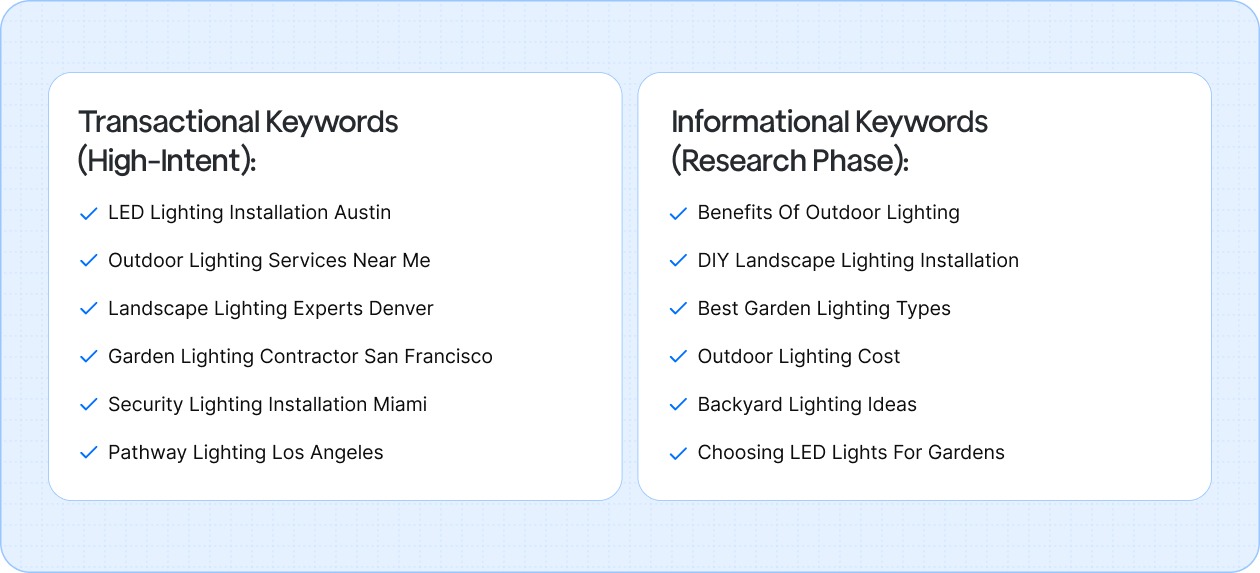
Optimizing your content for the right keywords is key to reaching people who need your services.
To truly stand out in local searches, SEO for landscape lighting companies is crucial. By implementing strategies like schema markup, quality backlinks, and strong technical SEO, you can increase your visibility and establish authority.
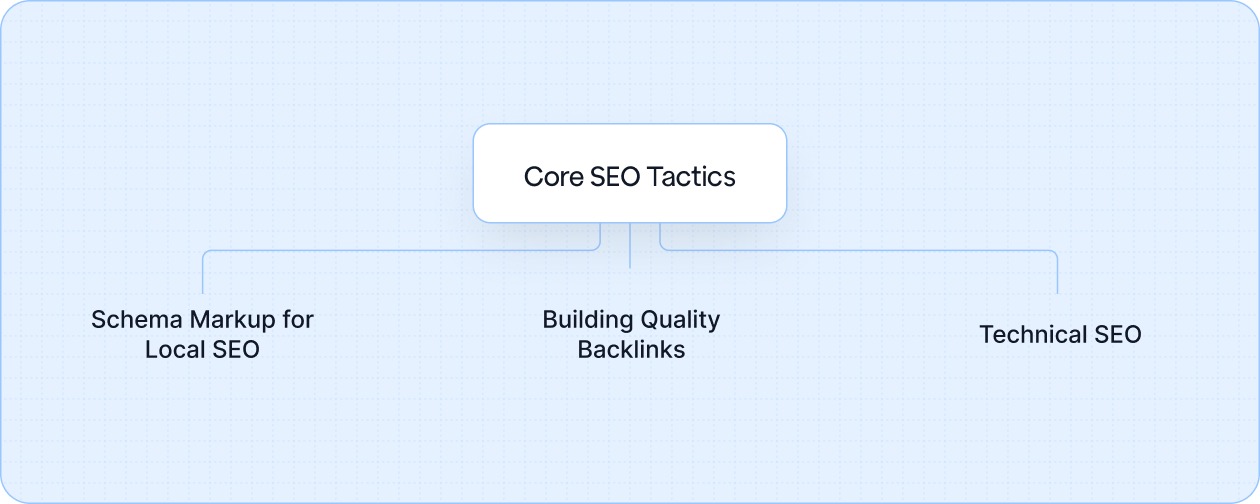
These efforts, backed by digital marketing services for landscape lighting firms, ensure that your business is found by the right local audience, driving long-term success.
Implementing schema markup (like LocalBusiness and Service schema) is essential for improving SEO for landscape lighting companies. It helps search engines display your business details clearly in search results, increasing your visibility in local searches.
Why It Matters: With the right schema, your business appears in rich snippets, improving both visibility and trustworthiness.
For landscape lighting firms, this makes it easier for local customers to find you when searching for services like "outdoor lighting installation" or "garden lighting design."
Acquiring quality backlinks from local business directories, industry blogs, and authoritative websites is a proven way to enhance SEO.
For digital marketing services for landscape lighting firms, these backlinks signal credibility to search engines, improving your site’s domain authority.
Why It Works: Trusted backlinks improve your ranking and establish your authority. A digital marketing agency for landscape lighting companies can help you build a strong link profile, driving local traffic and improving your SEO efforts.
Technical SEO ensures your site is fast, mobile-friendly, and easy to crawl by search engines. These factors are crucial for providing a smooth user experience and improving rankings.
To truly gauge the effectiveness of your SEO efforts, it’s essential to track key metrics and continuously refine your strategy.
Regular analysis helps you stay ahead by identifying areas of improvement and ensuring your landscape lighting business remains visible to the right audience.
To gauge the effectiveness of your SEO efforts, it's essential to keep an eye on key metrics that show how well your website is performing. These metrics help you understand what's working and where improvements are needed, ensuring your landscape lighting business stays visible to the right audience.
The key to sustained success is ongoing SEO optimization. Regularly reviewing performance data allows you to fine-tune your strategy and continuously improve your rankings.
Use insights from your data to keep optimizing content that resonates with your audience and adjust tactics that need more attention.
Also Read: Your Landscaping Business Is Losing $10,000 A Month To Invisible SEO Mistakes. Here’s The Fix.
Local SEO, content marketing, and continuous optimization are key to standing out and growing your landscape lighting business online.
Target the right keywords, create engaging content, and refine your strategies based on performance data. You set yourself up for long-term success and visibility in local searches.

Marketing your plastic rubber business requires making smart, strategic choices with your budget. A well-planned budget helps you:
With the right approach, your marketing budget becomes a powerful tool for growth in 2026. Let’s explore how to allocate your resources effectively and set your business up for success.
A well-planned marketing budget is crucial for driving growth and ensuring long-term success in the plastic and rubber industry. It helps you stay competitive, maximize ROI, and position your brand effectively. With the right budget, you can:

Allocating your marketing budget effectively means targeting resources where they’ll have the greatest impact. Here are the key factors to guide your decisions:
Different customer segments, like manufacturers, automotive companies, and construction firms, have unique needs. Personalize your marketing to address those specific priorities: cost-efficiency for manufacturers, performance for automotive clients, and durability for construction firms.
Not all marketing channels are created equal. Trade shows are great for building B2B relationships, especially in industries like automotive and manufacturing. Digital marketing, on the other hand, offers long-term visibility and consistent engagement. Choose wisely to avoid overextending on low-return channels.
Focus your budget on high-value areas. Invest in content marketing and SEO for sustainable brand growth. For immediate engagement, consider direct sales or event marketing, but remember to balance the costs with expected returns. Prioritize strategies that will scale as your business grows.
Must Read: Machinery Buyers Do 70% of Research Online Before Sales - Is Your Brand Visible In Search?
When it comes to planning your marketing budget, precision is key. Allocating your resources effectively ensures your marketing efforts align with your business’s growth, production cycles, and market demands. Here’s how to approach it:
This means prioritizing high-return marketing activities and scaling back on less impactful strategies.
For example, if you're in the construction segment, allocate more funds during peak seasons when projects ramp up.
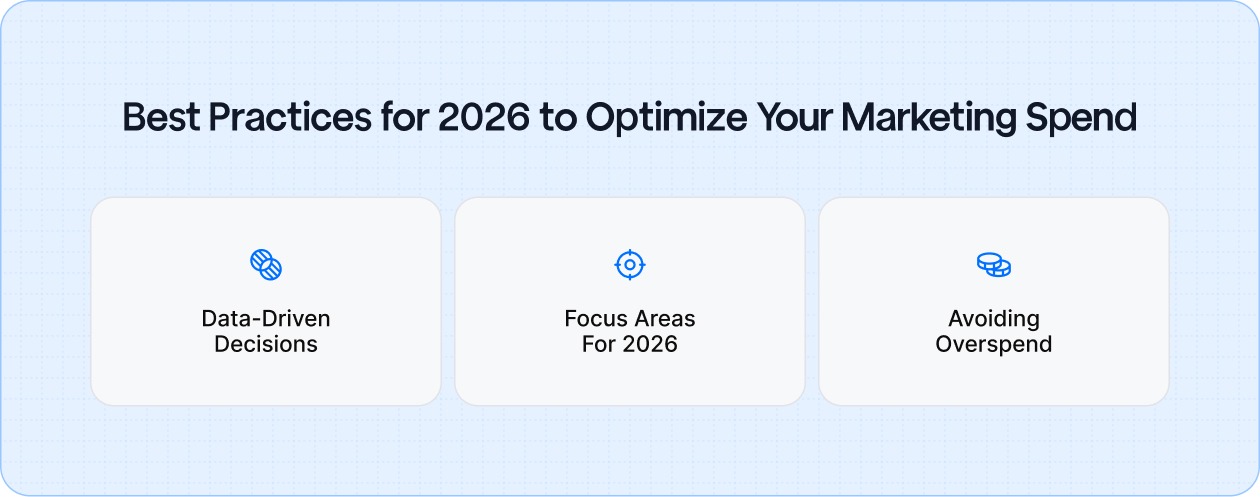
Maximizing your marketing budget requires spending smarter. To make every dollar work for you, here are the best practices to follow in 2026:
Tracking key metrics like Customer Acquisition Cost (CAC) and Return On Investment (ROI) is essential to optimizing your marketing spend. By understanding how much you're spending to acquire a customer and the return you're seeing from each campaign, you can make informed decisions.
For example, if one channel has a high CAC but low ROI, consider reallocating funds to strategies that are performing better. Monitoring these metrics regularly will help you ensure that your spend is aligned with your goals and maximizing value.
Prioritize high-ROI strategies like content marketing, SEO, and paid ads. Content marketing helps build long-term brand trust and improves organic traffic, offering sustained value over time. SEO helps improve your online visibility without constant costs, making it an essential part of your strategy.
Regularly assess your marketing channels to avoid wasting resources. If a channel isn’t performing as expected, scale back or cut it out altogether. Reallocate funds to areas that are showing higher returns.
A great way to do this is through A/B testing, which helps identify what works and what doesn’t, allowing you to refine your strategy. Stay flexible and ready to adjust your spend as needed, ensuring that your budget is always directed toward high-impact areas.
Must Read: Plastics and Rubber Manufacturers Must Adopt These 5 Strategies
Planning for the long term is critical for staying ahead in the plastic rubber industry. While short-term adjustments are necessary, a growth-focused approach to budgeting will help secure your business's future. Here's how to set your marketing budget up for long-term success:
Allocate a portion of your marketing budget for long-term initiatives that will fuel sustainable growth. Consider these areas:
A rigid marketing budget can hinder your ability to adapt to market shifts. Build flexibility into your plan to respond to unexpected challenges, such as:
Regular budget reviews and performance audits help ensure that your marketing efforts are aligned with your business goals and market conditions. Consider the following:
Suggested Read: We Analyzed 25+ Top Manufacturing Websites - The Winners Follow These Simple Steps
While creating a marketing budget is a crucial step for any plastic and rubber manufacturer, it’s equally important to avoid common pitfalls that can lead to wasted resources and missed opportunities.
Here are some key mistakes to watch out for:
One of the biggest risks in budgeting is setting unrealistic expectations for your marketing spend. This often happens when:
Without tracking the performance of your marketing activities, you risk overspending on underperforming tactics. Common issues include:
Tools that offer automated reporting can help streamline this process and ensure you're staying on track.
Failing to monitor and analyze what your competitors are doing with their marketing can lead to missed opportunities. Here’s why it matters:
As we approach 2026, it’s clear that the key to long-term success in the plastic and rubber industry lies in a well-structured marketing budget. By strategically allocating resources, measuring performance, and staying adaptable, you can:
Your marketing budget should be a strategic tool that powers your business forward. It’s time to fine-tune your plan, adapt to new opportunities, and invest in initiatives that align with your long-term vision.

Dry cleaning is a competitive, margin-sensitive business. New stores open, delivery apps enter the market, and customers switch providers more easily than before. In that environment, being good at the service is no longer enough. Visibility plays a direct role in whether your business grows, plateaus, or slowly loses ground.
SEO, with its new and best upcoming trends, have become one of the few channels that compounds over time for dry cleaners.
In this blog, we break down what the best SEO for dry cleaners looks like in 2025, the strategies that actually influence local growth, and which SEO services are best positioned to support long-term, organic performance.
SEO for dry cleaners in 2026 is still about one core goal: getting nearby customers to choose your store when they need cleaning services. What has changed is how search engines decide who gets shown and why. Search is more contextual, more local, and more selective about which businesses it trusts.
To compete today, dry cleaners need to focus more on clarity, accuracy, and real usefulness at the exact moment a customer is ready to act.
2025 accelerated three trends you can’t ignore: AI-driven result summaries, stricter helpful-content signals, and an even stronger emphasis on mobile and local signals.
For dry cleaners, these changes reward businesses that are easy to understand, easy to trust, and easy to contact.
In 2026, SEO for dry cleaners is shaped by one reality: search engines are trying harder to behave like customers.
These trends reflect how search engines now assess local service businesses and what dry cleaners must prioritize to remain visible and competitive:
Local SEO remains the primary driver of discoverability for dry cleaners. Most searches are immediate, and customers typically choose from a small set of nearby options surfaced in Maps or local results.
AI now shapes and surfaces question-type and comparison queries. Clear, structured, question-and-answer content is more likely to be pulled into AI overviews and conversational results.
Google prioritizes content that shows real experience, expertise, authority and trust. For dry cleaners that means practical, local, and experience-led content.
Search rewards pages that load fast and behave predictably, on mobile first. Core Web Vitals are still central: faster pages convert better and keep rankings stable.
Structured data helps search engines and AI understand your services and increases eligibility for rich snippets, hours, and FAQ cards.
Technical hygiene and targeted on-page optimisation are how you convert local visibility into bookings.
Local links, contextual mentions, and accurate directory listings still matter — but quality beats quantity. A few relevant local links move the needle more than dozens of unrelated directories.
Trust elements are ranking signals and conversion drivers. Treat them as a single system.
Track a small set of high-value KPIs and review them weekly. Metrics should tie back to revenue and repeat business.
The services below stand out for their ability to support local service businesses and drive steady, organic growth when executed correctly.

Gushwork focuses on SEO that is built around how local service businesses actually get customers. For dry cleaners, that means showing up at the exact moment someone searches nearby, understands the service quickly, and takes action without friction.
What makes Gushwork a strong fit for dry cleaning businesses:
For dry cleaners that want SEO to translate into predictable foot traffic and pickup requests, Gushwork offers a focused, practical approach grounded in how local service businesses really grow.
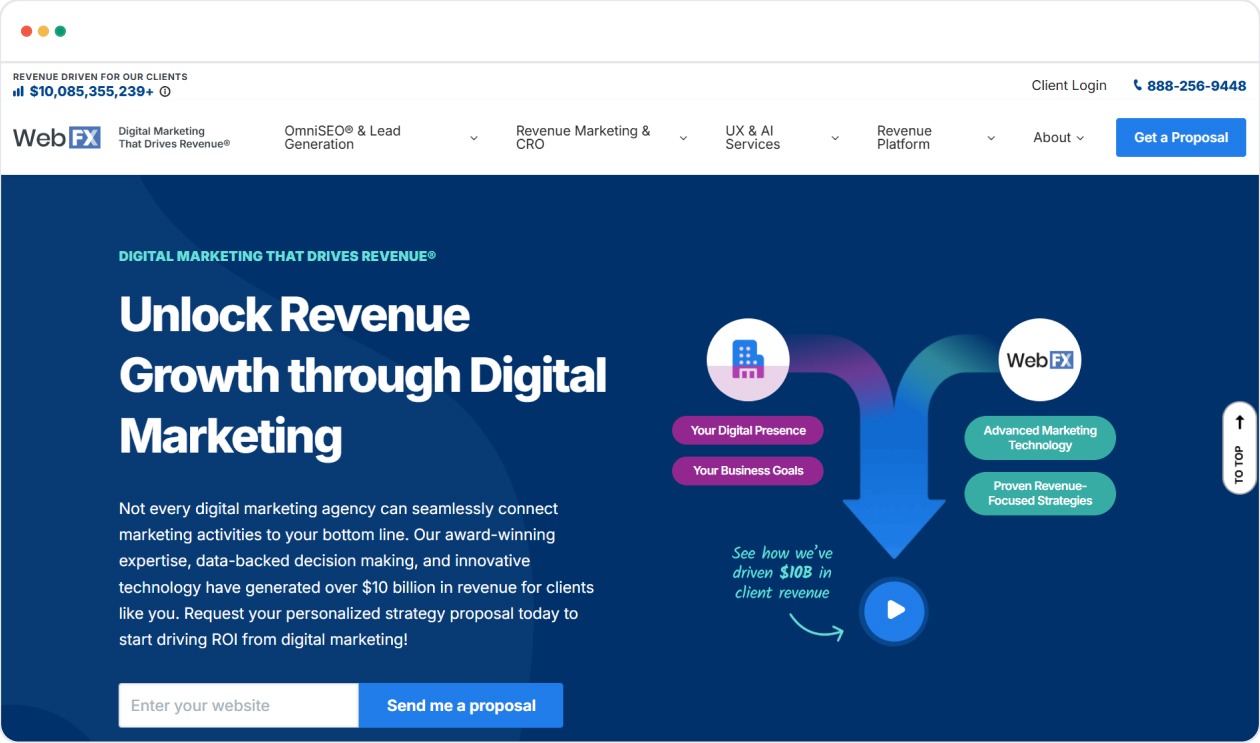
WebFX is a well-known digital marketing agency with experience across multiple local service industries. Their SEO services are structured and scalable, making them suitable for dry cleaning businesses with multiple locations or expansion plans.
Strengths include:
However, their approach can feel standardized, which may require additional customization for niche local services.
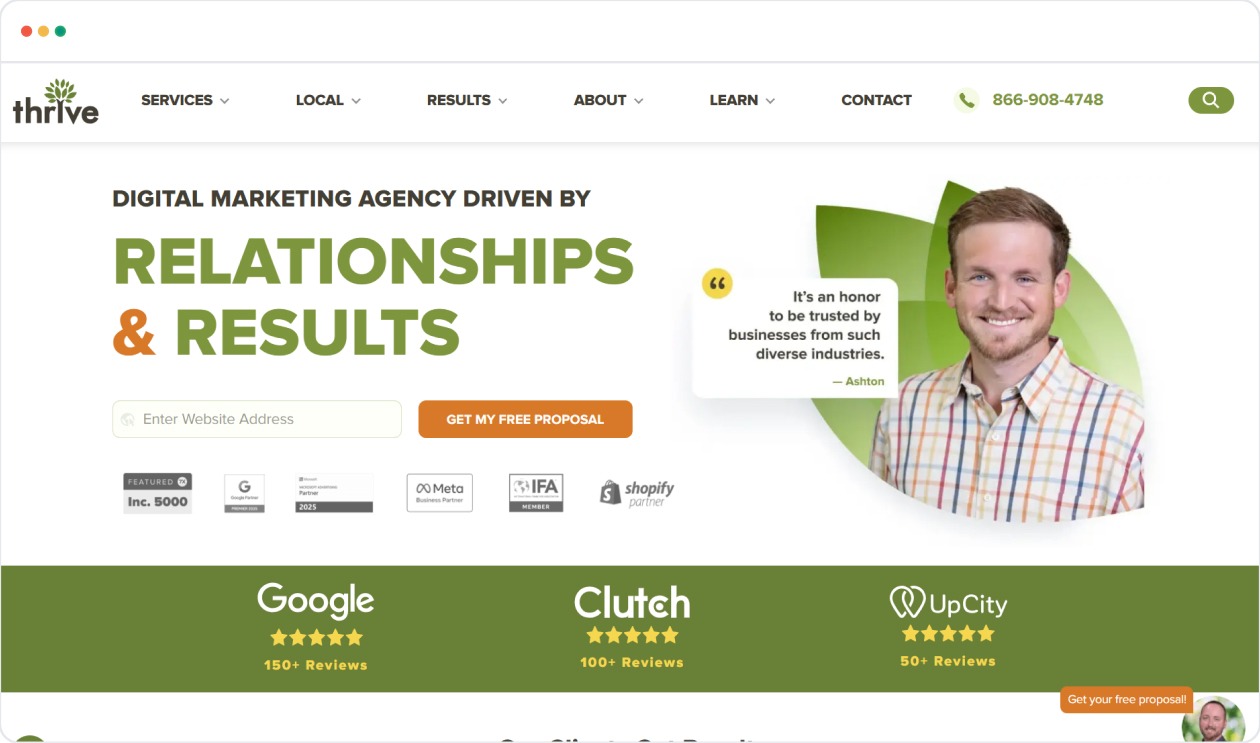
Thrive focuses on local SEO and reputation management, which aligns well with dry cleaners that rely heavily on local trust and visibility.
Notable areas:
Thrive works best for businesses that want consistent local presence improvements rather than aggressive growth experimentation.

Straight North specializes in lead-driven SEO and works with service businesses that prioritize inbound inquiries. Their approach is data-heavy and conversion-focused.
Key offerings:
This can be a good fit for dry cleaners that already understand their funnel and want to optimize performance.
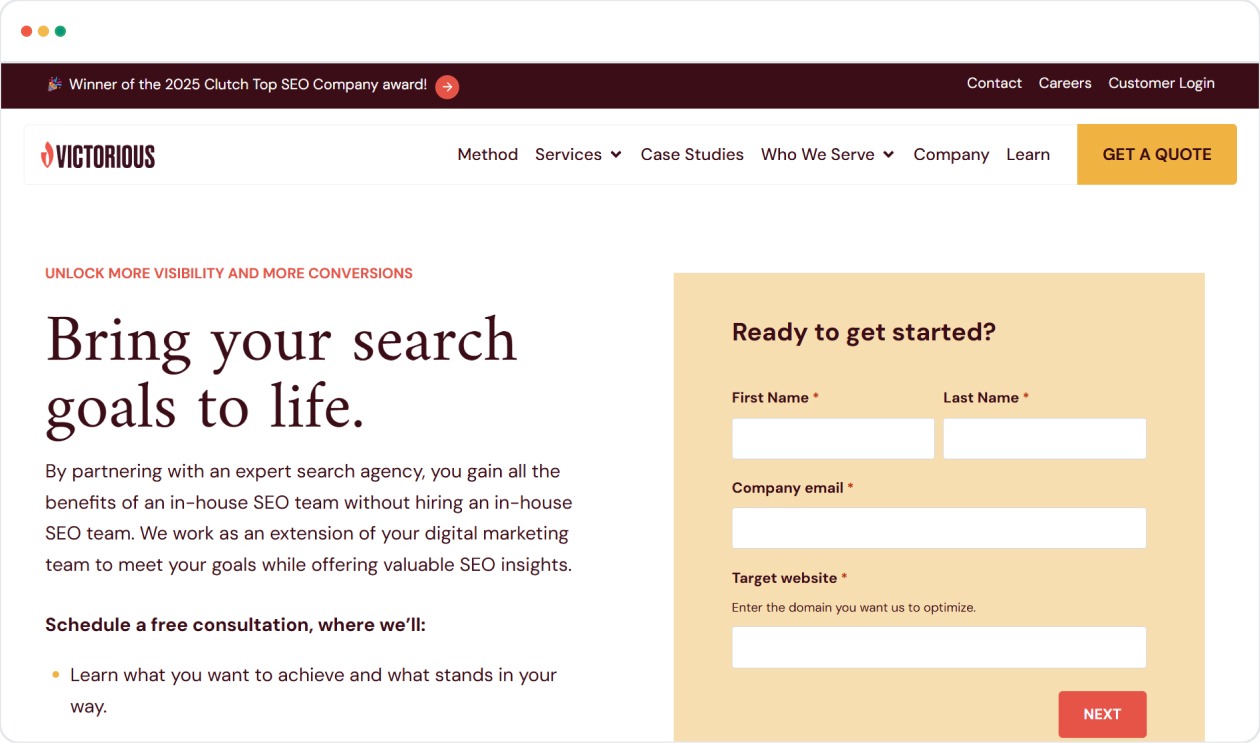
Victorious SEO is known for its technical depth and enterprise-grade SEO execution. While not exclusively focused on local services, their strategies can benefit larger or multi-location dry cleaning operations.
Where they perform well:
For smaller dry cleaners, their services may feel more complex than necessary, but they can be effective at scale.
The best SEO for dry cleaners is about building a strong local presence that holds up over time. Accurate listings, clear service pages, solid technical foundations, and steady trust signals create an advantage that competitors can’t easily copy.
As search continues to evolve, dry cleaners that invest in SEO as a long-term growth channel will rely less on discounts, paid ads, and one-off promotions. Instead, they’ll benefit from consistent demand and stronger brand recognition in their local market.
When SEO is treated as an asset rather than an experiment, it becomes one of the most reliable ways to grow a dry cleaning business organically.

As more people turn their homes into smart, connected spaces, the need for skilled wiring professionals has never been greater. But with so many businesses offering similar services, how do you stand out?
The answer lies in effective marketing. The right skills does get the job done. But it’s more about ensuring potential customers know you’re the one to trust for their smart home needs.
In this blog, we’ll explore practical marketing strategies to help your smart home wiring business build strong partnerships, attract the right clients, and position yourself as the go-to expert in this booming industry.
The smart home technology industry operates at the intersection of innovation and trust. Buyers are often interested but cautious, evaluating solutions based on reliability, integration, and long-term value rather than novelty alone.
This makes marketing less about awareness and more about helping prospects understand where a solution fits, how it works in real environments, and why it’s a safe decision.
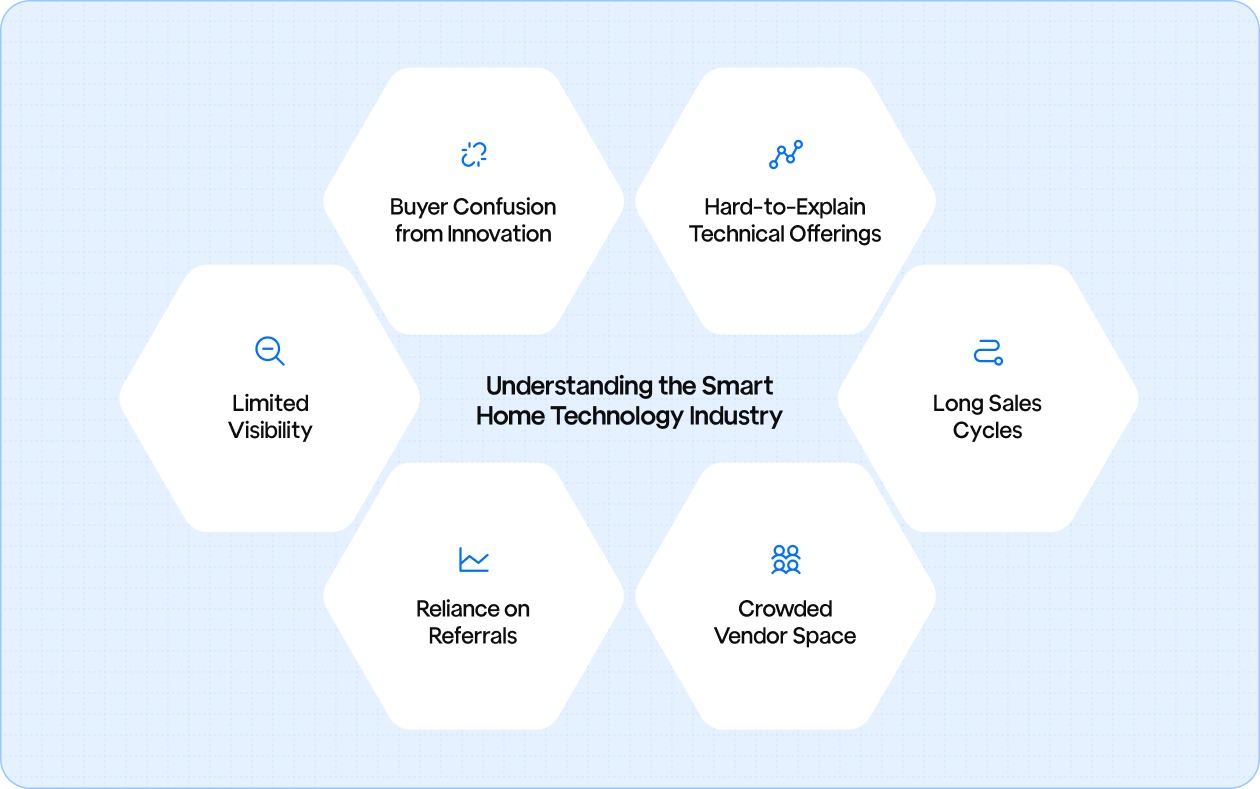
Below are the manufacturing marketing challenges most smart home technology companies face:
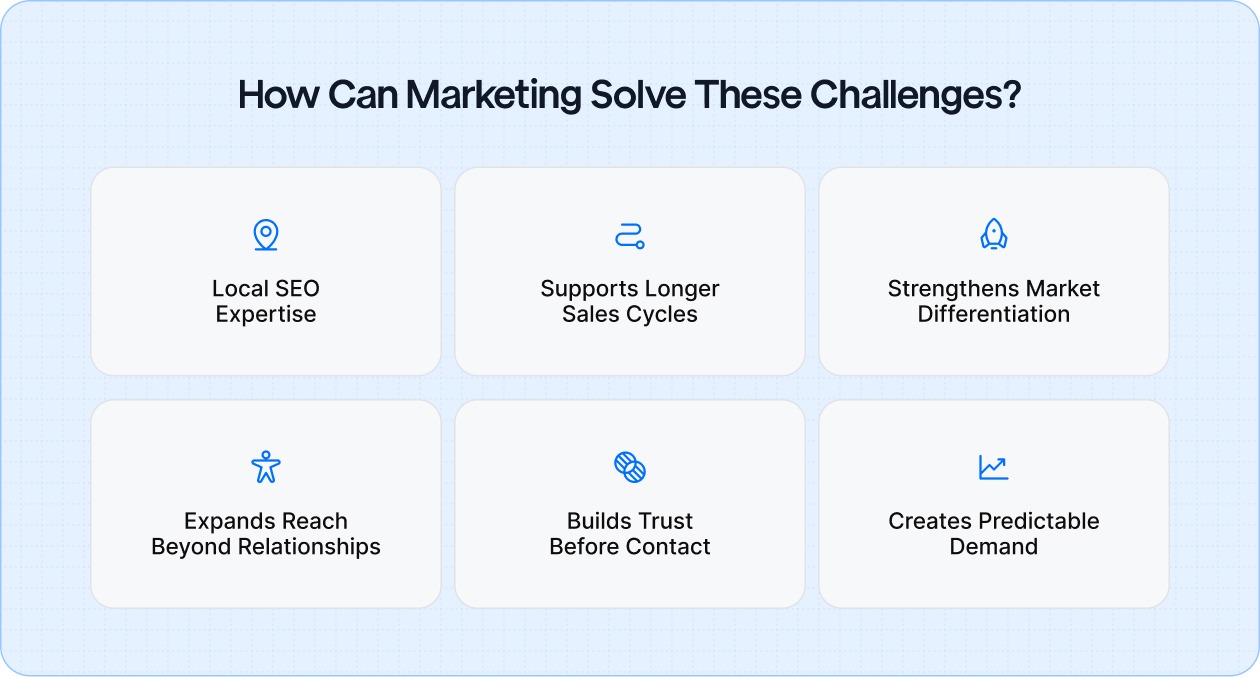
This shift allows smart home technology businesses to grow without disrupting how projects are sold or delivered, while staying competitive in this industry.
Smart home services sit at the intersection of electrical expertise and modern home improvement. Promoting them effectively requires a mix of education, visibility, and trust-building, especially in a market where most customers are still learning what’s possible.
The strategies below reflect how businesses can market smart home wiring and setup services to align with buyer intent in the home improvement services market.
Smart home technology is best marketed to people who are already thinking about improving their homes. Targeting the wrong audience leads to confusion and wasted effort.
Your website should clearly explain your smart home services in simple terms. SEO, at its core, is about making sure people can find those explanations when they search online.
Case studies replace uncertainty with proof. They show customers what smart home work actually looks like in real homes.
Social media and ads are most effective when they show real work and stay educational rather than promotional.
Most smart home objections come from uncertainty. Educational content helps remove that uncertainty before the sales conversation starts.
When customers talk about their experience, it carries more weight than any marketing message.
Manufacturer partnerships make your services feel safer and more credible to customers unfamiliar with smart home technology.
Link building strengthens search visibility by showing search engines where your business fits in the smart home ecosystem.
International SEO and marketing apply when your services or partnerships extend across regions or countries. The goal is controlled expansion, not broad global reach.
Seeing and discussing options in person helps customers feel confident in their decisions.
Marketing works best when it explains benefits clearly and speaks to real-life situations.
Digital PR helps smart home wiring businesses build visibility and trust in places partners and buyers already pay attention to. The focus is on credibility.
Workshops allow customers to learn without feeling pressured to buy.
Interest drops quickly when scheduling is difficult. When a buyer tries to reach out to you, you must ensure every path is simple for them.
Smart home marketing only delivers value when performance is tied back to real outcomes. Visibility alone is not enough. What matters is whether interest turns into inquiries, projects, and long-term clients.
The focus should be on how promotion efforts translate into qualified leads, completed installations, and repeat work.
Key metrics to monitor:
Smart home marketing becomes easier to manage and scale when the right tools and partners are in place. The goal is to use the tools that directly support lead quality and loyalty returns.
The focus should be on tools that help attract the right prospects and clearly measure what each channel delivers.
Lead generation partners to consider:
If you want a partner that covers all of this without the usual guesswork, Gushwork combines industry-specific targeting, local demand capture, and performance-driven reporting to deliver SEO that is built to convert.
SEO and PPC tools that support optimization:
Using these tools consistently helps identify what’s working, where gaps exist, and which efforts deserve more focus. Over time, this creates a clearer, more efficient smart home marketing system.
The smartest growth in smart home wiring comes from earning placement.
When your business is woven into the way projects are planned, discussed, and handed off, marketing stops feeling like work. You’re not convincing people you’re capable. Your name comes up because it belongs there.
You don’t need to be everywhere. You need to be in the right rooms, with the right people, at the right moment. Build those connections well, and your business stops reacting to demand and starts shaping it.

Most CNC companies do excellent work, but very few explain it well online. Precision machining, tight tolerances, and specialized capabilities are hard to communicate on a website, especially when most buyers only give you a few seconds of attention.
That gap between what your shop can do and how it appears in search results is where many CNC businesses lose opportunities without realizing it.
SEO for CNC companies exists to close that gap.
In this blog, we break down how SEO works specifically for CNC companies, what’s changed in the way search works today, and how manufacturers can build long-term visibility that supports real business growth.
Search engines rely on signals. They read your pages, analyze how information is organized, and compare your site with others offering similar services. SEO for CNC companies essentially focuses on clearly defining services, processes, and expertise so that both search engines and buyers can understand them.
Because CNC buyers search based on process, precision, industry requirements, and trust signals, SEO for most manufacturing companies has shifted along with how those buyers evaluate suppliers.
As a result, SEO now operates across multiple layers, each aligned with how and where buyers search at different stages.
SEO for CNC companies operates differently depending on how the business sells. Some shops focus on local or regional visibility where proximity supports logistics or collaboration. Others compete nationally, supplying parts across states to buyers they may never meet. Advanced CNC manufacturers often work globally, attracting international buyers searching for specific processes, materials, or certifications.
GEO refers to optimizing your content so it can be understood, referenced, and recommended by generative AI tools such as ChatGPT and Google’s AI Overviews. This is one of the biggest changes SEO has seen in years.
CNC SEO has become split by intent. Informational content supports AI-driven research and early evaluation, while bottom-of-funnel pages are still responsible for converting high-intent buyers into quote requests. Both layers are required to move deals forward.
For CNC companies, this shift is an opportunity.
Your content strategy should do two things: help real manufacturing buyers find your business online, and give them clear, useful answers so they take the next step with you.
Here are 15+ proven SEO practices tailored for your audiences:
To craft effective SEO content for machine shops and manufacturers, it’s crucial to prioritize buyer needs over simply targeting keywords. When your content speaks directly to buyer pain points and goals, it’s more likely to convert visitors into leads.
Effective keyword targeting is a vital component of any successful SEO strategy. For CNC companies, using the right long-tail, buyer-intent keywords will help you attract more qualified leads who are actively searching for your services.
Optimizing individual pages on your website helps maximize your chances of ranking for a variety of terms, making your entire site work harder to attract leads.
Machine shops and manufacturers need to show their expertise and build trust. Educational content allows your business to position itself as an authority while helping potential customers solve problems they face.
Examples of beginner-friendly how-to guides to publish:
Internal linking is one of the most important SEO practices to improve website navigation and increase the chances of ranking for a variety of keywords. Properly executed internal linking enhances both user experience and search engine crawling.
For instance, “Learn more about our precision CNC machining services” will help users understand what the linked page offers while improving keyword relevance.
Fast-loading pages reduce bounce rates and increase time on site. From an SEO standpoint, page speed also influences how search engines evaluate user experience.
Search engines prioritize mobile-first indexing. This means your mobile site is the primary version evaluated for rankings, not the desktop version. A mobile-friendly site improves crawlability, engagement, and conversion potential.
Backlinks are one of the most important ranking factors for search engines. The quality and relevance of the websites linking to your content can improve your domain authority and increase your site’s chances of ranking higher.
Local SEO is critical for machine shops and manufacturers that serve specific geographic regions. Optimizing your website for local search will help you attract nearby industrial leads and stand out in a competitive marketplace.
Videos and multimedia content can significantly improve engagement, increase time on page, and help rank higher in search engine results. Visual content also helps explain complex manufacturing processes in an easily digestible format.
Having a well-structured website is critical to providing a good user experience and optimizing for search engines. A clear site structure helps both users and search engines find relevant content quickly.
Featured snippets occupy a prime position in search results, often appearing at the very top. These "Position Zero" results offer a significant opportunity for visibility. To improve your chances of being featured, structure your content in a way that search engines can easily extract for snippets.
For example, for the query “What is CNC machining?” offer a precise and simple answer at the top of the content: “CNC machining is a computer-controlled manufacturing process used to create precise parts from a variety of materials.”
Technical SEO ensures that search engines can crawl and index your website efficiently, which directly impacts your search rankings. By addressing technical SEO aspects, you improve the chances of your content being indexed correctly and ranked higher.
International SEO ensures that your content is visible to potential customers worldwide. If your CNC company serves clients across various regions, it's important to tailor content for local languages, cultures, and market needs.
Image search is a growing channel for product discovery. By optimizing your images for search engines, you can drive traffic and product inquiries directly from visual search results.
Repurposing content allows you to extend the reach of your best-performing material. By transforming existing content into different formats or across platforms, you can attract new audiences and keep your content fresh.
AI-generated content tools can assist with the content creation process, but it’s essential to ensure that the content remains authentic, valuable, and aligned with your brand’s voice. Here’s how you can use gen AI strategically.
Even companies that invest time and money into SEO often struggle to see results. In most cases, the issue is not effort, but misaligned execution. Manufacturing SEO has its own pitfalls, especially when strategies are copied from consumer or generic B2B playbooks.
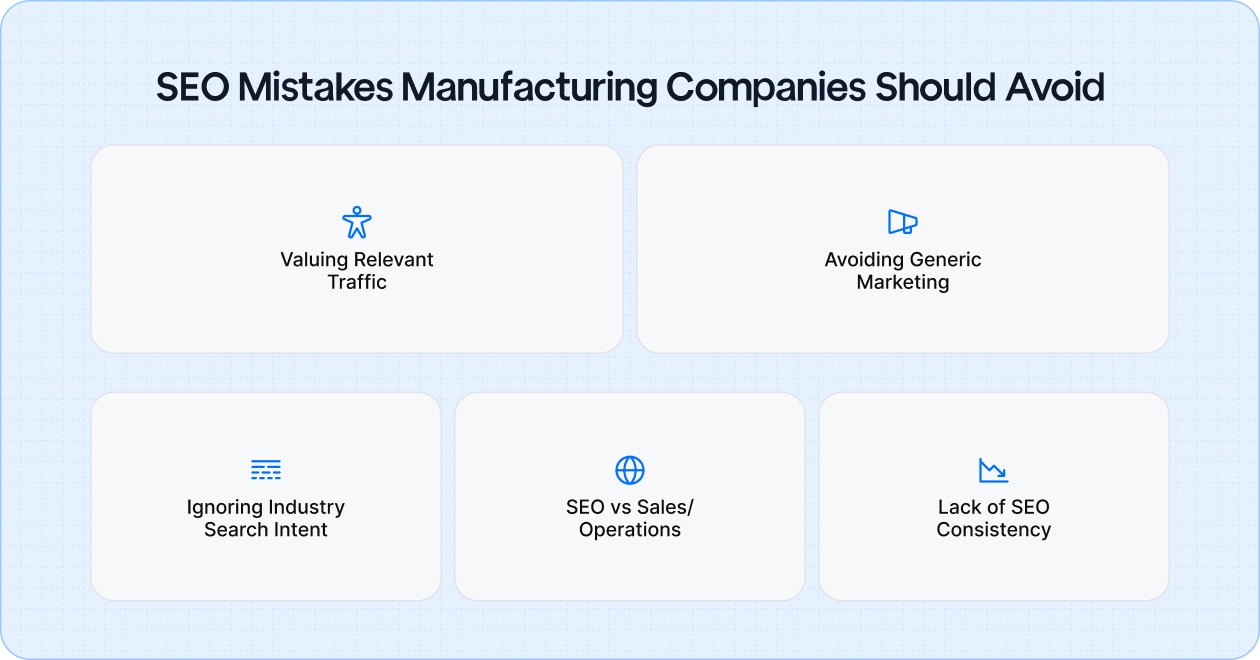
Below are common mistakes that quietly limit visibility, rankings, and lead quality for manufacturing and CNC businesses.
One of the most frequent mistakes is chasing traffic volume instead of buyer relevance. Manufacturing websites often rank for broad or informational terms that bring visitors who will never request a quote.
This leads to inflated traffic numbers with no commercial impact. SEO should prioritize searches tied to real purchasing intent.
Manufacturing buyers expect precision. When websites use vague claims or recycled marketing phrases, trust erodes quickly.
Search engines also struggle to understand pages that lack clear, specific context about processes, capabilities, and applications.
Manufacturing search behavior is highly specialized. Many companies fail by assuming buyers search the same way across industries.
Engineers, procurement teams, and operations managers use different terminology, specifications, and qualifiers when searching.
SEO often lives in isolation, disconnected from sales teams and production realities. This creates content that ranks but fails to convert because it does not reflect real-world capabilities.
Alignment ensures accuracy, relevance, and better lead quality.
Manufacturing SEO is not a short-term tactic. Companies that abandon efforts after a few months rarely see meaningful results.
Search visibility builds gradually through consistent execution and refinement.
For CNC businesses that invest in getting this right, SEO does more than improve visibility. It reduces friction in the sales process, improves lead quality, and positions your shop as a serious, reliable supplier in a crowded market.
If you want your CNC company’s expertise to be easier to find, easier to understand, and easier to choose, it starts with a focused SEO strategy built for how manufacturing search actually works.

Most plumbing businesses don’t lose jobs because of poor service or lack of demand. They lose them because there’s no clear marketing system guiding customers from first contact to booked work. Conversations happen, quotes are sent, interest is shown, but without a defined marketing approach, many of those opportunities quietly fade away.
When marketing is missing, communication becomes reactive because nothing was designed to keep the business top of mind.
Email marketing fits into this gap as a marketing channel. Used strategically, it supports the broader goal of staying visible, reinforcing value, and guiding customers toward action at the right time.
This guide will walk through email marketing best practices built specifically for plumbers who want smoother operations, better scheduling control, and a steady flow of work.
Email marketing is a straightforward way for businesses to stay connected with their customers by sending helpful, timely and relevant messages directly to their inbox.
For plumbers, this communication becomes especially valuable because most homeowners only think about plumbing when something goes wrong. Emails help you stay on their radar so that when they finally need help, your name is the first one they remember.

Email marketing will help you with these three things:
Email marketing is a steady line of communication that keeps the relationship warm, answers common questions and positions your plumbing business as the dependable choice whenever a need arises.
Below are 13 marketing-first email tactics that keep your plumbing business front-of-mind, convert hesitant inquiries into booked jobs, and drive repeat work without relying on extra ad spend.
Your email list is the foundation of every campaign. A clean list filled with real customers, interested leads and local homeowners performs far better than a huge list of random contacts. The goal is simple: gather emails only from people who want updates and make sure you store the right details so future messages feel personal and useful.
How to Execute
Segmentation means grouping customers based on their needs. A landlord doesn’t need the same reminders as a homeowner. A one-time emergency caller needs different follow-ups than a maintenance client. Segmenting ensures every email feels relevant, which increases opens, clicks and bookings.
How to Execute
A welcome series introduces new subscribers to your business and sets expectations. It helps customers understand what you do, when to call you and what makes your service reliable. A short, friendly sequence builds trust fast.
How to Execute
Plumbing issues often show up at predictable times, before winter, rainy seasons or a year after a previous repair. Sending helpful reminders reduces emergencies for your customers and builds predictable revenue for you.
How to Execute
Not every person books right after asking a question or requesting a quote. A short nurture sequence educates them, builds trust, and helps them make a comfortable decision without pressure.
How to Execute
Promotions should solve real business problems, such as filling slow days, reactivating old customers, or increasing average order value. Avoid going discount-first; use promotions as strategic nudges.
How to Execute
Your follow-up email is one of your strongest trust-building tools. It helps you get reviews, referrals and repeat work. Since customers just interacted with you, the response rate is usually high.
How to Execute
Educational content keeps your business top-of-mind without pushing sales. Homeowners appreciate practical advice they can use immediately.
How to Execute
Transactional emails, confirmations, invoices, technician-on-the-way alerts, have the highest open rates. They are perfect moments to build confidence and reduce customer uncertainty.
How to Execute
It’s normal for some customers to go quiet. Re-engagement campaigns help you reconnect with helpful value, not pressure.
How to Execute
Local context builds trust because plumbing issues vary by weather, water type and neighborhood. Small personal touches make emails feel written personally for them.
How to Execute
You don’t need to track everything. Focus on the few numbers that matter: engagement, bookings and customer value.
How to Execute
Good compliance keeps your emails trusted and ensures they reach inboxes, not spam.
How to Execute
Once your email strategy is defined, execution becomes the difference between emails that quietly support growth and emails that get ignored.
These best practices focus on how plumbing businesses should run email marketing day to day:
When email becomes part of your workflow, your business runs with fewer interruptions. Jobs move faster. Customers respond quicker. Leads don’t slip away. And you spend less time chasing and more time working.
Start with a few email templates, build a basic routine, and let the system take care of the follow-up and communication. When your email rhythm supports your operations, your plumbing business stops feeling reactive and starts running with a cleaner, more predictable flow.

Many people begin their search for septic tank services online, especially when they need help close to home. If your business doesn’t appear in search results or local listings, potential customers may choose another provider instead.
That’s where SEO steps in, making it easier for people to find your septic services when they need them. You can start with straightforward steps without needing a large marketing budget or a big team.
Let’s look at how septic tank services SEO training can help your business get noticed online.
SEO, or Search Engine Optimization, refers to improving your website so that search engines like Google can understand and rank it higher in search results. Here's how it works:
For septic businesses, SEO ensures that your company appears when people search for services you provide. Here’s how SEO benefits septic service businesses:

SEO offers long-term growth and stability for your business. Here's why it pays off:
By consistently implementing SEO strategies, your septic services can continue to grow and attract customers over the long haul.
Keyword research ensures that when potential customers search for septic services, your business appears in the results. Without it, even the best services can go unnoticed.
Long-tail keywords like “affordable septic tank pumping in Austin” or “emergency septic tank services in Dallas” are specific, easier to rank for, and attract customers who are ready to book.
Must Read: Want More Drain Cleaning Calls? Try These Powerful SEO Hacks Today
Your website content should be both helpful and relevant. Provide practical advice that addresses the needs of potential customers. For septic services, this could be guides on tank maintenance, troubleshooting common issues, or tips for keeping systems running smoothly.
The more useful your content, the more likely visitors will return and trust your business.
Metadata like page titles, meta descriptions, and headers help search engines understand your content and attract clicks. Here’s how to optimize them:
Your site’s performance directly affects your SEO. Make sure it’s mobile-friendly, fast-loading, and easy to navigate. Websites that deliver a smooth experience are rewarded with higher rankings.
Septic tank services website optimization focuses on making service pages clear, fast, and easy to understand for people looking for help.
Local SEO is the key to ensuring your septic services business stands out when customers are searching for solutions in your area.
To ensure your septic service business is visible to local customers, claiming and optimizing your Google My Business (GMB) and Apple Business Connect profiles is crucial. These platforms directly influence how you appear in local search results. Here’s what to do:
Active engagement on both platforms can improve your visibility and credibility. Here's how to make the most of GMB and Apple Business Connect:
Local SEO is all about connecting with customers in your area. By incorporating location-based keywords, you can increase your chances of being found by local searchers:
Suggested Read: How To Reach A Lead Searching For A Drain Cleaner In 30 Seconds?
Building local citations from trusted online sources can help you establish your business as relevant and credible in your area. This can significantly improve your local search visibility:
Off-page SEO is all about building your business’s credibility and authority online. By earning backlinks, engaging on social media, and managing your reputation, you create a strong digital presence that helps your septic service stand out in local searches.
These efforts improve visibility and build trust with potential customers.
Backlinks from reputable websites are crucial for building trust and improving your site’s authority. When high-quality sites link to you, search engines see this as a vote of confidence, increasing your visibility. Here’s how to earn them:
Earning septic tank services backlinks from credible sources improves trust and long-term visibility.
Engaging with your audience across multiple social platforms can significantly increase your business's visibility. Along with Facebook and Instagram, here are some other platforms to consider:
Septic tank services' social media optimization supports visibility by keeping your business active and consistent across platforms that customers already use.
Your online reputation is a reflection of your business, and managing it well can have a direct impact on customer trust and SEO. Here’s how to stay on top of it:
By actively managing your reputation, you’ll improve your SEO and build long-lasting trust with your customers.
Ensuring your website performs at its best is crucial for both user experience and search engine rankings. By focusing on site speed, mobile optimization, and structured data, you can enhance your website's usability and visibility.
These technical improvements lay the foundation for long-term SEO success.
With more people searching on mobile devices than ever before, having a mobile-friendly website is essential. Google evaluates websites using mobile-first indexing in its rankings, meaning if your site isn’t responsive, you’re missing out on valuable visibility.
Here’s how to ensure your site is mobile-ready:
Ensuring your site works well on mobile improves SEO rankings and enhances user experience, keeping visitors engaged.
Page load time directly affects both your rankings and user satisfaction. A slow-loading website can cause visitors to bounce, negatively impacting your SEO. Here’s how to speed things up:
Faster websites provide a better user experience and are more likely to rank higher in search results.
Structured data, also known as schema markup, helps search engines understand the content of your website. By adding schema, you improve the way your pages appear in search results, making them more engaging. Here’s how it works:
By implementing schema, you improve your SEO and the visibility of your website in rich search results, making it more likely that users will click on your page.
Effective content marketing drives visitors to your site and builds trust and authority in your industry. By providing helpful and informative content, you position your business as a go-to resource for customers.
Repurposing and strategically distributing that content ensures you're reaching a wider audience and keeping them engaged with your brand.
Your content needs to genuinely help your audience. Focus on delivering content that answers their questions and addresses their pain points. Here’s how:
Septic tank services SEO writing works best when the content is practical, easy to read, and focused on real customer questions.
Repurposing your content can help you reach a broader audience without reinventing the wheel. Turn your high-performing content into various formats:
This approach lets you maximize the value of each piece of content and engage with different segments of your audience.
Creating great content is only part of the equation; getting it in front of the right people is where distribution comes in. Share your content strategically to increase your reach:
By distributing your content on multiple platforms, you extend your reach and ensure potential customers see it at different touchpoints.
Tracking your SEO performance with tools like Google Analytics is crucial for understanding how your website is performing and where you can improve. Here’s what to focus on:
Tracking septic tank services web traffic helps you understand which pages bring visitors and which ones need improvement.
To measure keyword performance, Google Search Console provides insights into which terms are driving traffic to your website and how well they’re performing in search results. Key data to focus on includes:
By using Google Search Console, you get real-time insights into your keyword performance and can make adjustments to improve rankings.
SEO is a dynamic process that requires regular refinement based on performance metrics. Here's how to adjust your strategy:
By acting on the data you gather, you ensure that your SEO strategy remains agile, effective, and aligned with your goals.
As your business grows, so should your SEO strategy. Continuously refining your keywords, adding fresh content, and using paid ads alongside organic SEO efforts will help ensure long-term success.
These ongoing improvements create a strong foundation for your website to attract more customers and maintain visibility.
SEO is not a one-time task; keyword optimization is an ongoing process that evolves as your business grows. As you scale, your target audience and their search intent may shift, and so should your keyword strategy. Here’s how to refine it over time:
Constantly adjusting and expanding your keyword focus ensures that your SEO remains aligned with your business growth and continues driving relevant traffic.
As your business evolves, so should your content. Regularly adding fresh, high-quality content improves SEO and keeps your audience engaged and coming back for more. Here’s why ongoing content expansion matters:
Regularly posting new, relevant content ensures that your site continues to provide value, stays competitive in search rankings, and meets the evolving needs of your customers.
While SEO is essential for long-term growth, pay-per-click (PPC) ads can offer an immediate improve, helping to complement your organic strategy.
Combining these two strategies creates a well-rounded digital marketing approach that delivers short-term results and builds long-term sustainability. Here's how they work together:
By integrating paid ads with SEO, you create a comprehensive marketing plan that addresses both immediate needs and long-term growth.
Now that you’ve learned the essential SEO strategies for your septic services business, it’s time to put them into action.
From refining your keyword strategy to creating valuable content and incorporating local SEO, each step builds on the other to improve your online visibility.
SEO is a long-term commitment, but with consistent effort, the results will follow.

You handle drywall installation and repairs, but attracting new clients can be tricky and relying on word-of-mouth can only go so far.
Mobile marketing can help put your business in front of the right people at the right time. With just a few simple steps, you can make sure your services are easy to find when local customers need them.
Here’s how mobile marketing can help:
Next, this guide will walk through the exact steps on how to use these tools to start getting more business.
Most of your customers are on their phones, so if your website isn’t mobile-friendly, you’re already losing business. Mobile optimization is an essential tool for turning your website into a lead generator.
When a potential customer looks for drywall services, they want to quickly find your contact information and get an easy way to book your services. A mobile-optimized website ensures your visitors aren’t frustrated by slow loading times or hard-to-navigate pages.
Remember the last time you searched for a local service on your phone. How easy was it to find the right business? For your drywall business, local SEO is the key to showing up in those crucial search results.
By focusing on local keywords like “drywall repair in Miami” or “drywall installation near me,” you ensure that when customers are looking for your services, your business is the first one they find.
Must Read: Stop Being Invisible! Local SEO Will Get Your Remodeling Business the Recognition It Deserves
Social media is one of the best ways to show potential clients your work. Facebook, Instagram, and Twitter can help you build trust with your audience while showcasing your drywall expertise.
Sharing before-and-after photos, customer reviews, or time-lapse videos of your projects can build social proof and help you stand out.
Paid ads like Google Ads or Facebook Ads are effective because they capture demand that already exists. The beauty of paid search ads is that you can target people who are actively looking for your services, meaning your marketing dollars go further.
Must Read: Handyman Services: 6 SEO Tips to Get You Noticed, No Tools Required!
When it comes to staying in touch with clients, SMS marketing offers the best of both worlds: it’s personal, direct, and highly effective.
A simple SMS reminder about an appointment or a follow-up message about a job can strengthen your relationship with your clients and ensure they return.
People trust reviews. That’s why client reviews on platforms like Google and Apple Business Connect are so valuable for drywall businesses.
Happy clients can help you get more business by spreading the word about your quality service. It’s a powerful, cost-effective way to grow your reach.
Email marketing still holds its place as one of the most effective ways to keep clients engaged. By offering useful content, like drywall tips, seasonal promotions, or maintenance reminders, you can stay top-of-mind with your clients long after the job is done.
Tracking your results is important to improve. Use tools like Google Analytics and Facebook Ads Manager to track what’s working and adjust your strategy.
As your business grows, scaling doesn’t have to mean spending more. Repurpose content, increase your budget gradually, and focus on retaining clients.
Must Read: How a Building Material Supplier Cut Lead Costs 42% - The Digital Marketing Strategy You Can Use
Mobile marketing offers drywall businesses a clear path to growth, without the need for a big marketing team. By starting small with the right tools, like mobile optimization and local SEO, you can begin seeing results quickly and efficiently.
The key is consistency: track your progress, refine your approach, and scale smartly as your business grows.
To drive lasting success, it’s crucial to focus on SEO and content strategy. Begin with simple changes, optimize your website for mobile, target local customers, and create content that speaks to their needs. Measure what works, adjust as needed, and keep building from there.

In the world of construction, time is money, and the right equipment can make all the difference. Getting your machinery in front of the right people isn't always as straightforward as you would like it to be.
As a construction equipment dealer, you know that word-of-mouth and traditional ads aren't always enough anymore. With more buyers turning to the internet to research and purchase equipment, digital marketing has become the key to reaching the right audience at the right time.
This blog will guide you through proven digital strategies that will help your business stand out, connect with the right customers, and drive meaningful results, all without the need for a large marketing team or big budget.
Your website is your business’s online hub that helps potential customers easily find what they need and connect with you. To make the most of it:
Your website should be designed to convert visitors into leads. A clean, well-structured site that makes it easy to understand what you offer and how to reach you will help potential clients take the next step.
A Google Business Profile is essential for local visibility. It helps your business appear in relevant searches, especially when buyers are looking for equipment near them.
Customer reviews significantly impact your reputation and SEO. More positive reviews increase your business's trustworthiness and improve local search results.
Must Read: How to Win at Digital Marketing for Heavy Equipment Companies
For construction equipment dealers, organic marketing is the key to sustained growth. By focusing on content that educates and builds trust, you can establish a solid reputation that keeps attracting quality customers.
Organic marketing requires creating a foundation for long-term success.
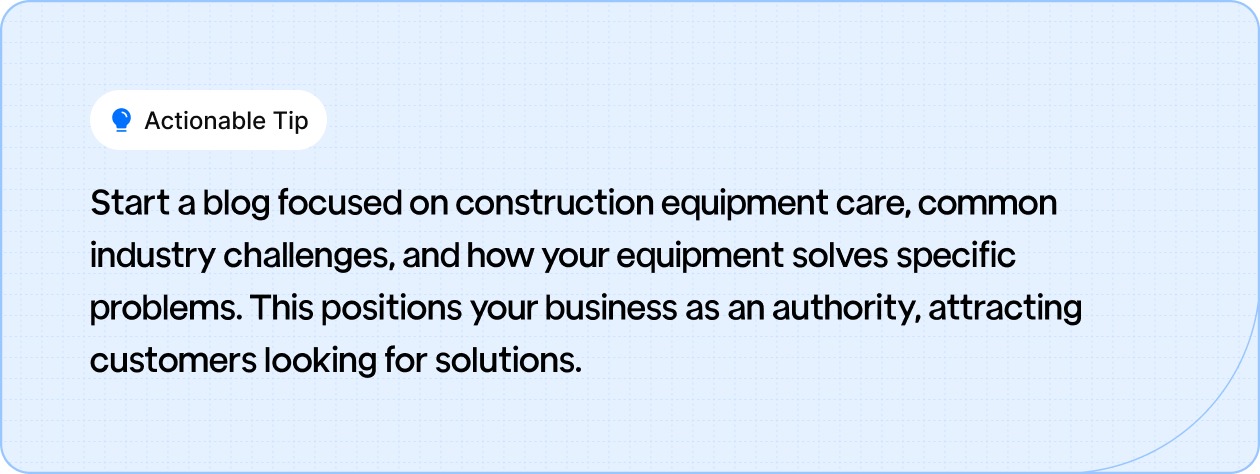
Content only works if you're speaking to the right audience. Understand who your buyers are and what drives their decisions.
In the construction equipment industry, where high-investment decisions are made, trust is essential. Video marketing is an invaluable tool for building that trust, providing a more personal, engaging way to connect with potential buyers.
It allows you to showcase your equipment, highlight its capabilities, and demonstrate real-world results in ways that text and images simply can’t match.
Video offers an unmatched level of engagement by putting your equipment in action. It's a powerful tool for showcasing how your machinery works on-site, especially in the demanding conditions of a construction project.
Buyers can see your equipment performing in real environments, which builds confidence and credibility, especially when they can visually understand how it will help them solve their challenges.
Must Read: How a Building Material Supplier Cut Lead Costs 42% - The Digital Marketing Strategy You Can Use
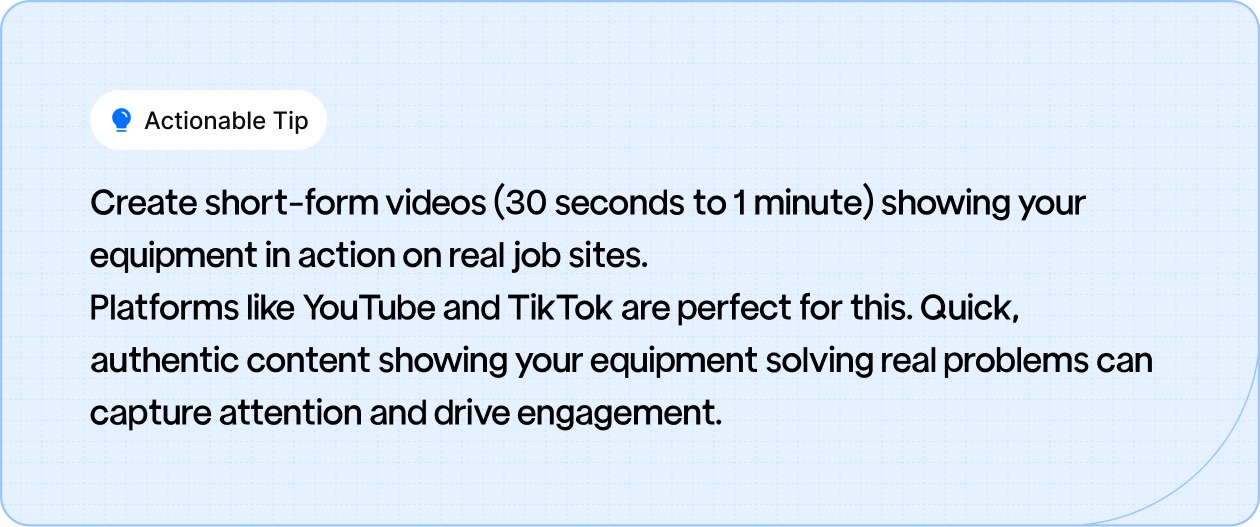
Storytelling through video is about weaving a narrative that speaks directly to your potential buyers' pain points. A successful video tells the story of a problem a customer faced, the challenge they needed solving, and how your equipment provided the solution.
Paid advertising, especially PPC campaigns, can be a powerful tool for generating immediate leads in the competitive construction equipment market.
PPC ads allow you to quickly put your high-demand equipment in front of the right buyers.
Using PPC allows construction equipment dealers to target specific decision-makers across industries like construction, mining, and agriculture.
Platforms like Google Ads and LinkedIn are ideal for reaching key buyers who are actively looking for machinery or equipment rental services.

Success in digital marketing is about tracking progress, evaluating results, and making data-driven decisions that guide your business toward sustainable growth.
For construction equipment dealers, understanding the effectiveness of your marketing efforts is crucial, and continuously improving based on solid metrics will ensure that your strategies stay relevant and effective.
The first step in measuring success is to set clear, specific goals for what you want to achieve. Using tools like Google Analytics, CRM systems, and social media insights gives you the ability to see how your efforts are performing and whether they're actually driving qualified leads.
Set up KPIs personalized to your equipment types and sales process. For example, track the number of leads generated by excavator-related content or skid steer rental inquiries.
This will give you insights into which products are resonating most with your audience and where to focus future efforts.
Once you have the data, it’s time to use it to refine your approach. Whether it’s improving your PPC campaigns, optimizing your website based on user behavior, or adjusting your email marketing strategy, data is your guide to making informed changes.
Give It a Read: Machinery Buyers Do 70% of Research Online Before Sales - Is Your Brand Visible In Search?

As we've explored, driving qualified traffic and securing leads in the construction equipment sector doesn't happen overnight. It requires a holistic strategy that blends digital presence, targeted campaigns, and consistent evaluation.
From building a strong website and establishing credibility with Google Business Profiles to refining your paid ads and leveraging video content, each step plays a crucial role in connecting with your ideal customers.





.svg)
.svg)
.svg)